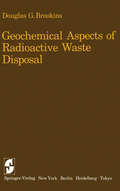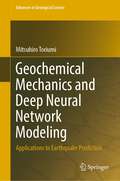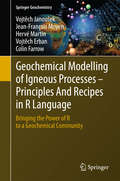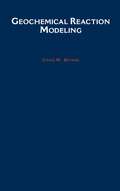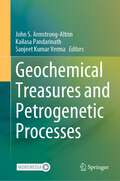- Table View
- List View
Geobiotechnology I: Metal-related Issues (Advances in Biochemical Engineering/Biotechnology #141)
by Axel Schippers Franz Glombitza Wolfgang SandThis book review series presents current trends in modern biotechnology. The aim is to cover all aspects of this interdisciplinary technology where knowledge, methods and expertise are required from chemistry, biochemistry, microbiology, genetics, chemical engineering and computer science. Volumes are organized topically and provide a comprehensive discussion of developments in the respective field over the past 3-5 years. The series also discusses new discoveries and applications. Special volumes are dedicated to selected topics which focus on new biotechnological products and new processes for their synthesis and purification. In general, special volumes are edited by well-known guest editors. The series editor and publisher will however always be pleased to receive suggestions and supplementary information. Manuscripts are accepted in English.
Geobiotechnology II: Energy Resources, Subsurface Technologies, Organic Pollutants and Mining Legal Principles (Advances in Biochemical Engineering/Biotechnology #142)
by Axel Schippers Franz Glombitza Wolfgang SandThis book review series presents current trends in modern biotechnology. The aim is to cover all aspects of this interdisciplinary technology where knowledge, methods and expertise are required from chemistry, biochemistry, microbiology, genetics, chemical engineering and computer science.Volumes are organized topically and provide a comprehensive discussion of developments in the respective field over the past 3-5 years. The series also discusses new discoveries and applications. Special volumes are dedicated to selected topics which focus on new biotechnological products and new processes for their synthesis and purification.In general, special volumes are edited by well-known guest editors. The series editor and publisher will however always be pleased to receive suggestions and supplementary information. Manuscripts are accepted in English.
Geobotanik: Pflanze und Vegetation in Raum und Zeit
by Wolfgang Frey Rainer LöschDas Buch vermittelt bewährtes geobotanisches Grundlagenwissen ebenso wie die in jüngerer Zeit erarbeiteten Aspekte der Geobotanik. Es schließt die anwendungsbezogenen Bereiche der Vegetationskunde und des Naturschutzes ein und greift über in die Geowissenschaften und in die Land- und Forstwirtschaft. Die 3. Auflage wurde detailliert überarbeitet und erweitert. Die Berücksichtigung von aktuell publizierter Literatur auch zu spezielleren Themen erhöht den Nutzen des Buches auch als Handbuch und Nachschlagewerk für Fortgeschrittene.
Geobotanik: Pflanze und Vegetation in Raum und Zeit
by Wolfgang Frey Rainer LöschDiese Softcover-Ausgabe, die ein unveränderter Nachdruck der 3. Auflage (2010) ist, hält das nachgefragte Lehrbuch weiterhin verfügbar. Die 3. Auflage wurde detailliert überarbeitet und erweitert. Die Berücksichtigung von aktuell publizierter Literatur auch zu spezielleren Themen erhöht den Nutzen des Buches als Handbuch und Nachschlagewerk für Fortgeschrittene.Dargestellt werdenGeschichte der Geobotanik und aktuelle ForschungstrendsFloristik, Arealkunde und PhylogeographieVegetationskundeFloren- und VegetationsgeschichtePflanzenökologieökologische Anpassungen und Lebensstrategien der PflanzenVegetationsgebiete der Erde mit Schwerpunkt Mitteleuropabotanische Aspekte von Natur- und Umweltschutz.Das Buch vermittelt bewährtes Grundlagenwissen ebenso wie die in jüngerer Zeit erarbeiteten Aspekte der Geobotanik. Es schließt die anwendungsbezogenen Bereiche Vegetationskunde und Naturschutz ein und greift über in die Geowissenschaften und in die Land- und Forstwirtschaft.
GeoBritannica: Geological Landscapes and the British Peoples
by Mike Leeder Joy LawlorGeoBritannica concerns the geological legacy of Britain, an inheritance bequeathed by its bedrock to the peoples who have lived on the island for the eleven millennia since the final spasms of the last Ice Ages. The authors explain the geological diversity of the landscape and the raw materials that it provides. They show how these materials have been utilised by society and by individuals in creative acts of the imagination. The reader will discover how regional environments and resources have enabled and inspired endeavours as diverse as planning, mining, quarrying, architecture, literature and the visual arts.The authors provide a modern interpretation of the geological history of Britain and place this in its historic, social and artistic contexts. Why is geology so fascinating to us? How do geologists do their science? Why are the differing landscapes what, where and how they are? What is the nature of the geological foundations of the British landscapes? How have geological discoveries developed our understanding of the landscape of Britain over the past two hundred years? What is the geological context of the raw materials used in past and present industries and for historic and vernacular buildings? How have geological landscapes and materials influenced past and present architects, visual artists and writers?This is a book for those wanting to develop a better understanding of Britain and to develop their love and understanding of the island which we inhabit.
Geocells: Advances and Applications (Springer Transactions in Civil and Environmental Engineering)
by T. G. Sitharam Amarnath M. Hegde Sreevalsa KolathayarThis book is designed to serve as a comprehensive resource on cellular confinement systems or geocells, covering technologies and their applications in geotechnical engineering. The book discusses all aspects of geocells and related technologies, and covers the subjects from conceptual basics to recent advances. The chapters of this book are written by renowned international experts and its contents include detailed case studies from both academic and industry experts. This book is a one-stop reference work for academicians, students, and practicing engineers in the global geotechnical community.
Geochemical Approaches to Environmental Engineering of Metals (Environmental Science and Engineering)
by Rudolf ReutherIt is not long ago that scientists realized, our study and understanding of most environmental problems call for a cross-sectional, more holistic view. In fact, environmental geochemistry became one of the legs to stand on for such a required interdisciplinary approach. Geochemists do not only describe the elemental composition and pro cesses of natural systems, such as soils, ground or surface waters, but they also establish the methodology to quantify material rates and turnover. Today, geochemical expertise has become indispensable when monitoring the fate of noxious chemicals, like-metallic pollu tants released to the environment. To know how trace metals will be have and react in complex systems under changing conditions, might provide us with a more realistic estimate of what is really acceptable in terms of quality standards. This would ease the formulation of ade quate environmental objectives, strategies and criteria to handle emerging pollution situations. Moreover, to take notice of geochemi cal principles will support our endeavor to improve the way we deal with limited and nonrenewable resources. It is exactly here, i. e. at the interface between natural elemental processes and the way we use them, that geochemical approaches meet the demand of technical at tempts to minimize the impact of environmentally relevant activities, like mining, waste handling, or manufacturing. The consideration to include geochemically derived concepts into the search for technical solutions is not really new, but has a long tradition during the evolution of modern societies.
Geochemical Aspects of Radioactive Waste Disposal
by D. G. BrookinsThere is an extremely voluminous literature on radioactive waste and its disposal, much in the form of government-sponsored research reports. To wade through this mountain of literature is indeed a tedious task, and it is safe to speculate that very few, if any, individuals have the time to examine each report that has been issued during the preceding ten years. This book attempts to summarize much of this literature. Further, many workers in the geosciences have not received training in the nuclear sciences, and many nuclear scientists could be better versed in geology. In this book an attempt is made to cover some background material on radioactive wastes and geotoxicity that may not be an integral part of a geologist's training, and background material on geology and geochemistry for the nuclear scientist. The geochemical material is designed for both the geoscientist and the nuclear scientist. There is no specific level for this book. Certainly, it should be useful to advanced undergraduates and graduates studying geology and nuclear science. It does not pretend to cover a tremendous amount of detail in all subjects, yet the references cited provide the necessary source materials for follow-up study. It is my intention that the reader of this book will have a better, broader understanding of the geochemical aspects of radioactive waste disposal than is otherwise available in anyone source.
Geochemical Behavior of Levoglucosan in Tibetan Plateau Glacier Snow and Ice (Springer Theses)
by Chao YouThis book focuses on geochemical behavior and ancient records of the specific biomarker levoglucosan in Tibetan glaciers, Based on samples from the Zangsegangri (ZSGR) ice cores obtained from the central Tibetan Plateau, it presents annually resolved levoglucosan records and fire changes over the past 430 years. It also discusses the interaction between fire, climate change, and human activities. This is the first effort to reconstruct annual resolution fire records in Tibetan ice, providing crucial information and substantially improved analytical methods toward a better understanding of past fire changes.
Geochemical Biomarkers
by T.F. Yen J.M. MoldowanFirst Published in 1988. Routledge is an imprint of Taylor & Francis, an informa company.
Geochemical Biomarkers
by T.F. Yen J.M. MoldowanFirst Published in 1988. Routledge is an imprint of Taylor & Francis, an informa company.
Geochemical Exploration and Modelling of Concealed Mineral Deposits: A Treatise On Exploration Of Concealed Land And Offshore Deposits
by Ashoke K. TalapatraThis book discusses potential mineral belts in various geotectonic regions around the globe, with a particular focus on concealed deposits, in order to highlight new areas for geochemical exploration and modelling. In recent years, the application of statistical methods using qualitative and, wherever possible, quantitative earth science data has become increasingly common for the evaluation of both offshore and terrestrial mineral resources. The book examines these approaches and provides examples from India, which are also applicable to deposits around the world, particularly those in South and South East Asia.The main objective of geochemical exploration and modelling is to present the geometry of the deposit in three dimensions. As such, the book describes the various conventional and non-conventional techniques of exploration geochemistry, especially in the context of concealed terrestrial and offshore mineral deposits. It serves as a guide for field geologists, geochemists, students, research scholars and scientists interested in earth science for the exploration of concealed mineral deposits and evaluation of their resources.
Geochemical Exploration of the Moon and Planets (Physics and Chemistry in Space #3)
by I. Adler J. I. TrombkaThis book presents a review of those efforts that have been and are being made to determine the geochemical composition of the moon and planets. The authors have attempted to present both a review as well as their philosophy about the development of flight experiments for geo chemical studies. Their basic premise is that such flight experiments should emphasize the scientific objectives and a total systems approach to meeting these objectives, involving the analytical device, data handling and data interpretation. While the above seems reasonably obvious, many proposals of experiments often tend to begin with an instrument with too little concern about the constraints imposed and whether the data that can be obtained are sufficiently useful to meet the scientific objectives. This book covers the accomplishments in space science exploration, bearing on the history and composition ofthe solar system. 'It also covers the rationale behind the lunar and planetary exploration program. The latter part of the book is concerned with future plans for lunar and planetary exploration instrumentation and techniques in various stages of development. There is an exposition of the methods of remote analysis of the moon and planets, including some concepts developed by the authors as a result of their long term involvement with the space program, from its early inception to the present day preparation for remote geochemical analysis in the Apollo, Mariner and Viking missions.
Geochemical Exploration of the Moon and Planets (Physics and Chemistry in Space)
by Julian Gualterio Roederer Josef ZähringerGeochemical Kinetics
by Youxue ZhangThis book offers a comprehensive exploration of geochemical kinetics--the application of chemical kinetics to geological problems, both theoretical and practical. Geochemical Kinetics balances the basic theories of chemical kinetics with a thorough examination of advanced theories developed by geochemists, such as nonisothermal kinetics and inverse theories, including geochronology (isotopic dating), thermochronology (temperature-time history), and geospeedometry (cooling rates). The first chapter provides an introduction and overview of the whole field at an elementary level, and the subsequent chapters develop theories and applications for homogeneous reactions, mass and heat transfer, heterogeneous reactions, and inverse problems. Most of the book's examples are from high-temperature geochemistry, with a few from astronomy and environmental sciences. Appendixes, homework problems for each major section, and a lengthy reference list are also provided. Readers should have knowledge of basic differential equations, some linear algebra, and thermodynamics at the level of an undergraduate physical chemistry course. Geochemical Kinetics is a valuable resource for anyone interested in the mathematical treatment of geochemical questions.
Geochemical Mechanics and Deep Neural Network Modeling: Applications to Earthquake Prediction (Advances in Geological Science)
by Mitsuhiro ToriumiThe recent understandings about global earth mechanics are widely based on huge amounts of monitoring data accumulated using global networks of precise seismic stations, satellite monitoring of gravity, very large baseline interferometry, and the Global Positioning System. New discoveries in materials sciences of rocks and minerals and of rock deformation with fluid water in the earth also provide essential information. This book presents recent work on natural geometry, spatial and temporal distribution patterns of various cracks sealed by minerals, and time scales of their crack sealing in the plate boundary. Furthermore, the book includes a challenging investigation of stochastic earthquake prediction testing by means of the updated deep machine learning of a convolutional neural network with multi-labeling of large earthquakes and of the generative autoencoder modeling of global correlated seismicity. Their manifestation in this book contributes to the development of human society resilient from natural hazards. Presented here are (1) mechanics of natural crack sealing and fluid flow in the plate boundary regions, (2) large-scale permeable convection of the plate boundary, (3) the rapid process of massive extrusion of plate boundary rocks, (4) synchronous satellite gravity and global correlated seismicity, (5) Gaussian network dynamics of global correlated seismicity, and (6) prediction testing of plate boundary earthquakes by machine learning and generative autoencoders.
Geochemical Modelling of Igneous Processes – Principles And Recipes in R Language: Bringing the Power of R to a Geochemical Community (Springer Geochemistry)
by Vojtěch Janoušek Jean-François Moyen Hervé Martin Vojtěch Erban Colin FarrowThe aim of this book is to unlock the power of the freeware R language to advanced university students and researchers dealing with whole-rock geochemistry of (meta-) igneous rocks. The first part covers data input/output, calculation of commonly used indexes and plotting in R. The core of the book then focusses on the presentation and practical implementations of modelling techniques used for fingerprinting processes such as partial melting, fractional crystallization, binary mixing or AFC using major-, trace-element and radiogenic isotope data. The reader will be given a firm theoretical basis for forward/reverse modelling, followed by exercises dealing with typical problems likely to be encountered in real life, and their solutions using R. The concluding sections demonstrate, using practical examples, how a researcher can proceed in developing a realistic model simulating natural systems. The appendices outline the fundamentals of the R language and provide a quick introduction to the open-source R-package GCDkit for interpretation of whole-rock geochemical data from igneous and metamorphic rocks.
The Geochemical Origin of Microbes
by William F. Martin Karl KleinermannsThis is a textbook covering the transition from energy releasing reactions on the early Earth to energy releasing reactions that fueled growth in the first microbial cells. It is for teachers and college students with an interest in microbiology, geosciences, biochemistry, evolution, or all of the above. The scope of the book is a quantum departure from existing “origin of life” books in that it starts with basic chemistry and links energy-releasing geochemical processes to the reactions of microbial metabolism. The text reaches across disciplines, providing students of the geosciences an origins/biology interface and bringing a geochemistry/origins interface to students of microbiology and evolution. Beginning with physical chemistry and transitioning across metabolic networks into microbiology, the timeline documents chemical events and organizational states in hydrothermal vents – the only environments known that bridge the gap between spontaneous chemical reactions that we can still observe in nature today and the physiology of microbes that live from H2, CO2, ammonia, phosphorus, inorganic salts and water. Life is a chemical reaction. What it is and how it arose are two sides of the same coin.Key Features Provides clear connections between geochemical reactions and microbial metabolism Focuses on chemical mechanisms and transition metals Richly illustrated with color figures explaining reactions and processes Covers the origin of the Earth, the origin of metabolism, the origin of protein synthesis and genetic information as well as the escape into the wild of the first free-living cells: Bacteria and Archaea
The Geochemical Origin of Microbes
by William F. Martin Karl KleinermannsThis is a textbook covering the transition from energy releasing reactions on the early Earth to energy releasing reactions that fueled growth in the first microbial cells. It is for teachers and college students with an interest in microbiology, geosciences, biochemistry, evolution, or all of the above. The scope of the book is a quantum departure from existing “origin of life” books in that it starts with basic chemistry and links energy-releasing geochemical processes to the reactions of microbial metabolism. The text reaches across disciplines, providing students of the geosciences an origins/biology interface and bringing a geochemistry/origins interface to students of microbiology and evolution. Beginning with physical chemistry and transitioning across metabolic networks into microbiology, the timeline documents chemical events and organizational states in hydrothermal vents – the only environments known that bridge the gap between spontaneous chemical reactions that we can still observe in nature today and the physiology of microbes that live from H2, CO2, ammonia, phosphorus, inorganic salts and water. Life is a chemical reaction. What it is and how it arose are two sides of the same coin.Key Features Provides clear connections between geochemical reactions and microbial metabolism Focuses on chemical mechanisms and transition metals Richly illustrated with color figures explaining reactions and processes Covers the origin of the Earth, the origin of metabolism, the origin of protein synthesis and genetic information as well as the escape into the wild of the first free-living cells: Bacteria and Archaea
Geochemical Processes, Weathering and Groundwater Recharge in Catchments
by O.M. Saether P. de CaritatGeochemical Processes, Weathering and Groundwater Recharge in Catchments is a specialist book concerned with the natural processes taking place where water interacts with minerals and organic matter at the earth’s surface, in soils or within aquifers. It focuses on the all important interface between the hydrological and geochemical cycles in terrestrial ecosystems, and is thus particularly relevant to understanding the environment. The book is intended primarily as a reference text for graduate students in Earth Sciences, Hydrology or Environmental Sciences, but will be a useful introduction to those studying Chemistry, Biology or Forestry Studies. Geochemical Processes, Weathering and Groundwater Recharge in Catchments presents an overview of the current status of knowledge of catchment studies, with an outline of the challenges of future research. .
Geochemical Processes, Weathering and Groundwater Recharge in Catchments
by O.M. Saether P. de CaritatGeochemical Processes, Weathering and Groundwater Recharge in Catchments is a specialist book concerned with the natural processes taking place where water interacts with minerals and organic matter at the earth’s surface, in soils or within aquifers. It focuses on the all important interface between the hydrological and geochemical cycles in terrestrial ecosystems, and is thus particularly relevant to understanding the environment. The book is intended primarily as a reference text for graduate students in Earth Sciences, Hydrology or Environmental Sciences, but will be a useful introduction to those studying Chemistry, Biology or Forestry Studies. Geochemical Processes, Weathering and Groundwater Recharge in Catchments presents an overview of the current status of knowledge of catchment studies, with an outline of the challenges of future research. .
Geochemical Reaction Modeling: Concepts and Applications
by Craig M. BethkeGeochemical reaction modeling plays an increasingly vital role in several areas of geoscience, from environmental geochemistry and petroleum geology to the study of geothermal and hydrothermal fluids. This book provides an up-to-date overview of the use of numerical methods to model reaction processes in the Earth's crust and on its surface. Early chapters develop the theoretical foundations of the field, derive a set of governing equations, and show how numerical methods can be used to solve these equations. Other chapters discuss the distribution of species in natural waters; methods for computing activity coefficients in dilute solutions and in brines; the complexation of ions into mineral surfaces; the kinetics of precipitation and dissolution reactions; and the fractionation of stable isotopes. Later chapters provide a large number of fully worked calculation examples and case studies demonstrating the modeling techniques that can be applied to scientific and practical problems. Students in a variety of specialties from low-temperature geochemistry to groundwater hydrology will benefit from the wealth of information and practical applications this book has to offer.
Geochemical Sediments and Landscapes (RGS-IBG Book Series #72)
by David J. Nash Sue J. McLarenThis state-of-the-art volume reviews both past work and current research, with contributions from internationally recognized experts. The book is organized into fourteen chapters and designed to embrace the full range of terrestrial geochemical sediments. An up-to-date and comprehensive survey of research in the field of geochemical sediments and landscapes Discusses the main duricrusts, including calcrete, laterite and silcrete Considers deposits precipitated in various springs, lakes, caves and near-coastal environments Considers the range of techniques used in the analysis of geochemical sediments, representing a significant advance on previous texts
Geochemical Sediments and Landscapes (RGS-IBG Book Series)
by David J. Nash Sue J. McLarenThis state-of-the-art volume reviews both past work and current research, with contributions from internationally recognized experts. The book is organized into fourteen chapters and designed to embrace the full range of terrestrial geochemical sediments. An up-to-date and comprehensive survey of research in the field of geochemical sediments and landscapes Discusses the main duricrusts, including calcrete, laterite and silcrete Considers deposits precipitated in various springs, lakes, caves and near-coastal environments Considers the range of techniques used in the analysis of geochemical sediments, representing a significant advance on previous texts
Geochemical Treasures and Petrogenetic Processes
by John S. Armstrong-Altrin Kailasa Pandarinath Sanjeet Kumar VermaThis book highlights various aspects of geochemical and geological processes. In brief, it facilitates to understand the geochemical behavior of major, trace and rare earth elements in rocks to identify the magmatic processes involved in present-day magma generation and their relation to global tectonic regimes as well as geothermal studies. Therefore, the book provides a comprehensive view of the generation of magma types (mafic to felsic in composition) and their role in the petrogenesis. The book also covers the development of new geosoftware to effectively process the geochemical data before its interpretation.







